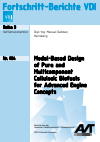Model-Based Design of Pure and Multicomponent Cellulosic Biofuels for Advanced Engine Concepts
Zusammenfassung
This thesis describes model-based strategies for the identification of pure and multicomponent cellulosic biofuels that exhibit tailored properties for use in high-efficiency, low-emission internal combustion engines. Based on the principles of computer-aided molecular design, algorithmic exploration of the molecular search space by means of carbon- and energy-efficient refunctionalization of bio-derived platform chemicals is combined with quantitative structure-property relationship (QSPR) and group contribution modeling of key physicochemical fuel properties including the derived cetane number. The resulting virtual fuel screening approach is applied to the task of identifying oxygenated fuel candidates for both spark-ignition and compression-ignition engines. Optimization-based formulation of 100%-renewable biofuel blends is performed by means of integrated product and pathway design. Application of the novel design methodology yields biofuel mixtures that exhibit both the desired p...
Schlagworte
- I–XVIII
- 1–9 1 Introduction 1–9
- 1.1 Structure of this thesis
- 1.2 Previous publications of contents and results
- 10–39 2 Basic concepts of fuel design 10–39
- 2.1 Physicochemical fuel properties and their impact on engine performance
- 2.1.1 Early-stage, rapid screening of fuel auto-ignition quality
- 2.1.2 Cellulosic biofuels studied in research engines
- 2.1.3 Perspectives on the definition of tailor-made fuels
- 2.2 Exploitation of the structure of lignocellulosic biomass
- 2.3 Carbon- and energy-efficient biofuel production
- 2.4 Computer-aided design of chemical products and fuels
- 2.4.1 Group contribution (GC) modeling
- 2.4.2 Quantitative structure-property relationship (QSPR) modeling
- 40–49 3 Targeted generation of candidate structures 40–49
- 3.1 Main principles in structure generation
- 3.2 Relations to rule-based reaction network generation
- 3.3 Pool-based scheme and implementation
- 50–82 4 GC-based prediction of fuel auto-ignition quality 50–82
- 4.1 Materials and methods for the rapid screening
- 4.2 Modeling strategy
- 4.2.1 Selection of the general model structure
- 4.2.2 Systematic model reduction
- 4.2.3 Proposition of the final model
- 4.2.4 Model validation
- 4.3 Model application and uncertainty
- 4.4 Conclusions and outlook
- 83–106 5 QSPR-based prediction of physicochemical fuel properties 83–106
- 5.1 Modeling strategy
- 5.1.1 Descriptor calculation, data pretreatment and outlier removal
- 5.1.2 Model derivation, validation and application
- 5.2 Comparison with GC-based prediction of thermophysical properties
- 5.3 QSPR-based prediction of fuel auto-ignition quality
- 5.4 Conclusions and outlook
- 107–129 6 Model-based identification of biofuel candidates 107–129
- 6.1 Candidates for spark-ignition (SI) engines
- 6.2 Candidates for compression-ignition (CI) engines
- 6.3 Conclusions and outlook
- 130–174 7 Blend formulation by simultaneous product and pathway design 130–174
- 7.1 Existing methodologies for computer-aided mixture design
- 7.2 Blend design framework for tailor-made fuels
- 7.3 Pathwaymodel
- 7.3.1 Extension of reaction network flux analysis
- 7.3.2 Biomass supply
- 7.3.3 Calculation of process performance measures
- 7.4 Fuel property models
- 7.4.1 Distillation curvemodel
- 7.4.2 Reid vapor pressure model
- 7.4.3 Phase stability criteria
- 7.5 Problem formulation and solution strategy
- 7.6 Case study: Blends for the spark-ignition (SI) engine
- 7.6.1 Scenario description
- 7.6.2 Results
- 7.7 Conclusions and outlook
- 175–178 8 Conclusions and outlook 175–178
- 179–226 Appendices 179–226
- A Transformation rules for molecular structure generation
- B Experimental ignition delay data
- C GC model for the derived cetane number
- C.1 Group decomposition and descriptor data
- C.2 Comparison of measurement data with results of GC model
- C.3 Sensitivity equations and covariancematrix
- D Derivation of QSPR models
- E Rational formulation of biofuel mixtures
- E.1 Application of Hoffmann-Florin equation
- E.2 Application of COSTALD method
- E.3 Trade-off analysis: Hydrogen demand vs. energy of fuel produced
- E.4 Data and references for the case study
- 227–276 Bibliography 227–276


